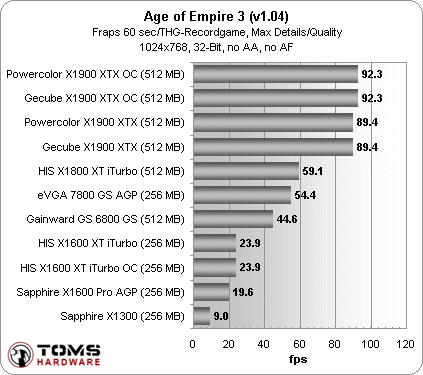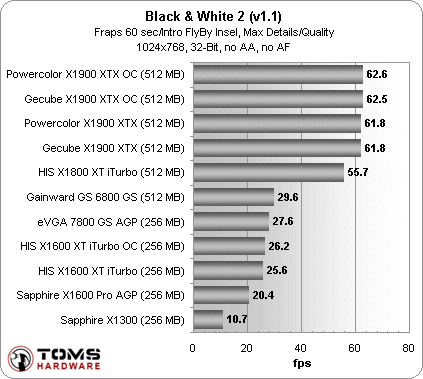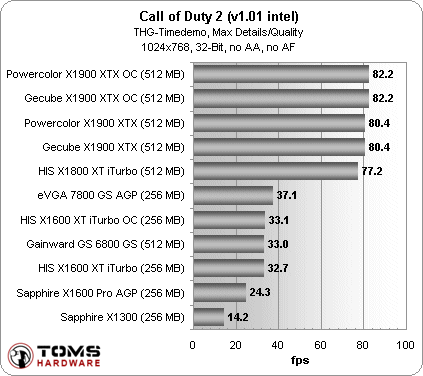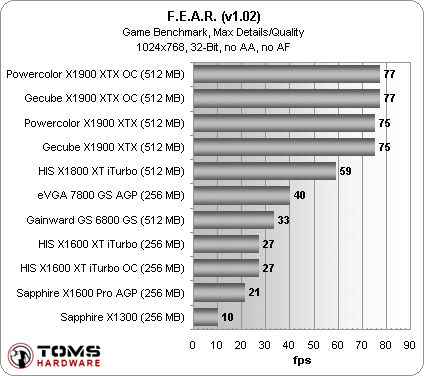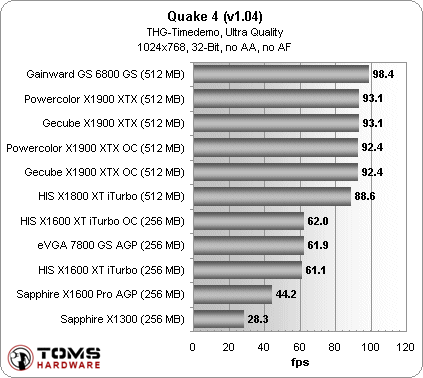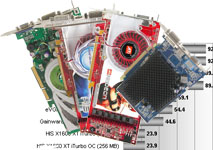 Published by: www.tomshardware.com
Published by: www.tomshardware.com
As hardware accessories are very important for the animators and computer graphics creators it is quite difficult to stay informed and choose the best solution for you. We bring you the digest focused on the hottest news in the graphic cards area originally published within the exhausting benchmark testing and details describing article in the TOMS hardware site.
Tested graphic cards overview table:
| Card Manufacturer and Chip | Code Name | Memory | HDR-R | Vertex Shader / Pixel Shader | GPU Frequency | Memory Frequency |
| NVIDIA Graphics Cards | ||||||
| Gainward GS BLISS 6800 GS PCX | NV42 | 512 MB GDDR3 | yes | 3.0/3.0 | 485 MHz | 1300 MHz |
| eVGA GeForce 7800 GS SC AGP | G70 | 256 MB GDDR3 | yes | 3.0/3.0 | 460 MHz | 1350 MHz |
| ATI Graphics Cards | ||||||
| Gecube Radeon X1900 XTX OC | R580 | 512 MB GDDR3 | yes | 3.0/3.0 | 690 MHz | 1600 MHz |
| Gecube Radeon X1900 XTX | R580 | 512 MB GDDR3 | yes | 3.0/3.0 | 648 MHz | 1548 MHz |
| Powercolor Radeon X1900 XTX OC | R580 | 512 MB GDDR3 | yes | 3.0/3.0 | 690 MHz | 1600 MHz |
| Powercolor Radeon X1900 XTX | R580 | 512 MB GDDR3 | yes | 3.0/3.0 | 648 MHz | 1548 MHz |
| HIS Radeon X1800 XT iTurbo | R520 | 512 MB GDDR3 | yes | 3.0/3.0 | 695 MHz | 1584 MHz |
| HIS Radeon X1600 XT iTurbo OC | RV530 | 256 MB GDDR3 | yes | 3.0/3.0 | 600 MHz | 1404 MHz |
| HIS Radeon X1600 XT iTurbo | RV530 | 256 MB GDDR3 | yes | 3.0/3.0 | 587 MHz | 1386 MHz |
| Sapphire Radeon X1300 | R515 | 256 MB DDR2 | yes | 3.0/3.0 | 452 MHz | 514 MHz |
| Sapphire Radeon X1600 Pro AGP | RV530 | 256 MB DDR2 | yes | 3.0/3.0 | 500 MHz | 810 MHz |
Graphic cards reviews
EVGA GeForce 7800 GS AGP
eVGA’s card uses a single-slot cooling solution. The cooler, which covers both the GPU and the memory modules, consists of a fan and aluminum cooling fins covered by an acrylic faceplate. The graphics chip provides support for Pixel Shader version 3.0 and HDR rendering. Our test sample was an eVGA “Superclocked Edition,” meaning it runs at increased clock speeds right out of the box. Thus, the GPU is clocked at 460 MHz, while the memory frequency is 1350 MHz. Thanks to its increased clock speeds and 256 MB of video memory, the card is ideally suited for current 3D games. Its target price is about $299.
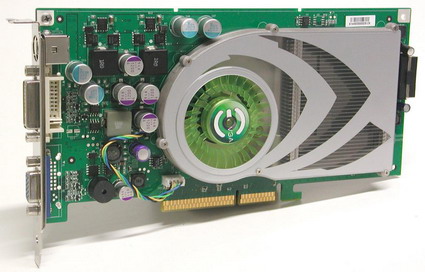
The eVGA GeForce 7800 GS AGP carries a full complement of output connectors, including DVI, standard VGA and Video Out.

Sapphire Radeon X1600 Pro AGP
A much less expensive upgrade for systems using the AGP interface is also available in the shape of the Radeon X1600 Pro. Costing only $120, it offers 57 percent of the performance of the GeForce 7800 GS. Like its rival, it too comes as a one-slot solution. The cooler covers both the GPU and the memory modules and consists of a fan and aluminum cooling fins covered. Although the GPU runs at a rather high 500 MHz, this potential advantage is thwarted by the memory, which runs at a mere 810 MHz. The card is an ideal upgrade for ATI fans on a budget that are looking for support for PS 3.0 and HDR with anti-aliasing enabled.
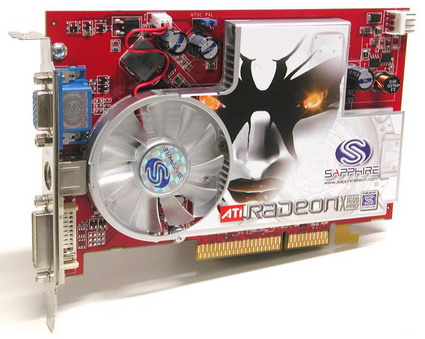
The Sapphire Radeon X1600 Pro AGP sports a DVI, an analog VGA and a Video Out connector.

Gainward Golden Sample BLISS 6800 GS PCX
Gainward is especially well known for its Golden Sample line of cards. These versions run at higher default clock speeds right out of the box. There are two advantages to this approach: first, it saves the user the tedious task of finding the ideal speed manually; and second, it preserves the warranty, since the increased frequencies are set and guaranteed by the manufacturer.
Of course, buying a standard card and then tweaking it to run at higher speeds is a cheaper alternative. However, the speeds that can be attained vary greatly from card to card, meaning that there is a certain risk involved – not to mention the fact that running any product outside of its specifications can void the warranty
Gainward equips its 6800 GS with 512 MB of video memory. With this increased texture buffer and its higher clock speeds, it has no trouble outpacing and replacing the 6800 Ultra. The card itself is a one-slot solution. The heatsink and fan only cool the GPU, while the memory modules carry their own aluminum heatsinks.
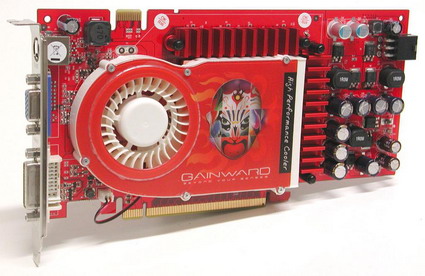
The Gainward 6800 GS comes with DVI, standard VGA and Video outputs.

Gecube Radeon X1900 XTX
This card follows ATI’s reference design; both the fast GPU and the memory are covered by a large cooling solution, and warm exhaust air is expelled from the computer case via air slits at the back of the card. Due to its size and weight, the massive cooler requires two expansion slots and secure mounting. The GPU is ideal for games with lots of eye candy that make extensive use of shader effects. This is a result of the enormous number of pixel shader units included in the new design, letting the X1900 XTX shine in games like F.E.A.R. and Oblivion.
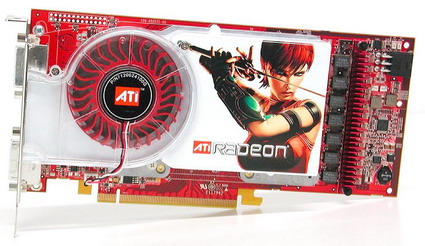
Gecube’s Radeon X1900 XTX features two digital DVI connectors, as well as a video output for S-Video or HDTV.
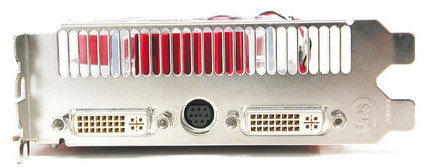
HIS Radeon X1600 XT ITurbo IceQ
This card’s designation contains two peculiarities. The first is the “iTurbo” moniker, which denotes higher clock speeds. Its default frequencies are 587/1386 MHz (GPU/memory), but when the iTurbo overclocking utility is activated, the board can be overclocked to 600/1404 MHz, literally with a single click.
The second special characteristic is the IceQ cooling solution, a two-slot silent cooler that pairs lower temperatures than the stock cooler with lower noise levels. On the front of the card’s box, HIS promises that the cooler reduces heat by 11°C while operating at less than 20dB(A). Indeed, the fan is practically silent. Warm air is expelled at the back of the case through a little grille that comes with the card. The long cooler covers both the graphics chip and the memory modules. The board supports Pixel Shader v3.0 and HDR rendering with simultaneous anti-aliasing. From a performance perspective, the X1600 XT is just over a third slower than the X1800 XL, meaning it is just fast enough for the current crop of complex 3D games.
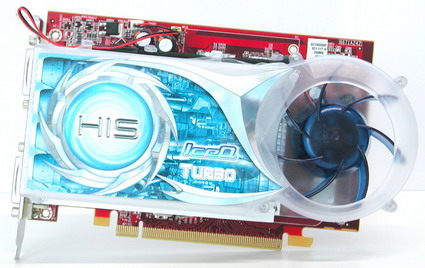
The HIS Radeon X1600 XT iTurbo IceQ supports two digital DVI- connectors and a Video-out jack for S-Video or HDTV.

HIS Radeon X1800 XT ITurbo
HIS may put stickers with its logo on the cooler and the fan, but beyond that, the hardware follows ATI’s reference design. The large cooler covers both the graphics processor and the memory. Warm exhaust air is pushed out of the case through the ATX shield at the back of the card. Due to the cooler’s size and weight, the card takes up two expansion slots and requires secure mounting. The X1800 XT’s performance is very good, which stems from the fact that HIS configures the card to run at higher clock speeds out of the box – an iTurbo sticker on the package promises a 700 MHz GPU clock and a memory speed of 1.6 GHz. The board supports Pixel Shader 3.0 and HDR rendering with simultaneous anti-aliasing. The XT version is the fastest chip of the X1800 family, and offers adequate performance for complex 3D games.
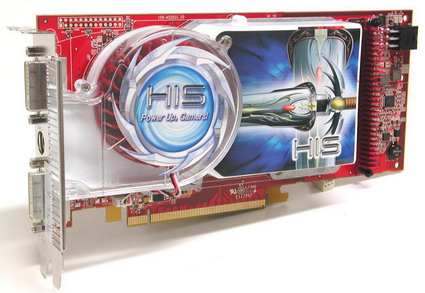
The HIS Radeon X1800 XT iTurbo features two digital DVI connectors and a video jack for S-Video or HDTV.

Powercolor Radeon X1900 XTX
Powercolor’s 3D accelerator follows ATI’s reference design completely; both the fast GPU and the memory are covered by the large cooling solution. Warm exhaust air is pushed out of computer case via a grille at the back of the card. Due to its size and weight, the massive cooler requires two expansion slots and secure mounting. The GPU is ideal for games with lots of eye candy that make extensive use of shader effects. This is a result of the enormous number of Pixel Shader units included in the new design, letting the X1900 XTX shine in games like F.E.A.R. and Oblivion.
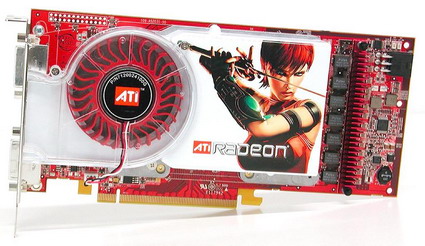
Powercolor’s Radeon X1900 XTX sports two digital DVI connectors and one video jack for S-Video or HDTV.

Sapphire Radeon X1300
Sapphire’s X1300 offering is designed as a single-slot solution. The heatsink, which covers both the GPU and the top-mounted memory modules, gets by without an active fan; the memory modules on the card’s back are not cooled. This generation of card supports Pixel Shader 3 and HDR rendering with simultaneous anti-aliasing. Nonetheless, GPU and memory are too slow for today’s complex 3D games. Thanks to its passive cooling solution, the card is ideally suited for a DVR or an office PC.
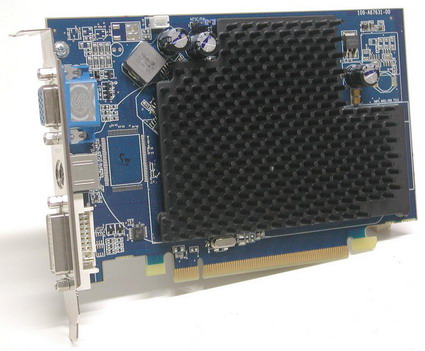
Sapphire’s Radeon X1300 comes with one DVI and one VGA connector, as well as a video jack.

eVGA GeForce7800 GS AGP
This board makes an excellent upgrade for AGP systems, and its performance is more than adequate for current 3D games. However, we would recommend pairing the card with a CPU running at least 2.4 GHz. Owners of brawnier AMD systems are likely to get another 10 to 20 percent more performance out of this AGP card. Our review sample was one of eVGA’s Superclocked models that run at higher default clock speeds.
Sapphire Radeon X1600 Pro AGP
This card is an inexpensive AGP upgrade for the ATI community. The board offers support for Pixel Shader 3.0 and HDR, and provides just enough performance for the current crop of complex 3D games. Owners of faster AMD systems will probably get an additional 10 to 20 percent more performance out of this AGP card. The full complement of cables that comes with the card also deserves praise.
Gainward Golden Sample BLISS 6800 GS PCX
Gainward’s Golden Sample runs at higher default clock speeds out of the box. With its higher frequencies and its 512 MB of video memory, the 6800 GS replaces the 6800 Ultra or GT in NVIDIA’s product line. It also comes with support for Pixel Shader 3 and HDR rendering. Performance-wise, the card comes in behind a Radeon X1800, which is nevertheless sufficient for current games.
Gecube Radeon X1900 XTX
This graphics chip is the fastest part on the market today, hands down. It is the ideal choice for games like Spellforce 2, F.E.A.R. or Oblivion, which make heavy use of shader effects. HDR rendering and anti-aliasing can be enabled together. The card’s bundle is good, although the video-editing suite Power Director 2.5 is already several versions outdated – Gecube’s competitors ship their cards with version 3 or 4. This card also offers enormous overclocking potential, and can be run at the highest possible settings.
HIS Radeon X1600 XT iTurbo IceQ
iTurbo does not have a huge impact on the card’s clock speeds. Its overclocking feature is activated using the bundled iTurbo utility; pressing the iTurbo button results in a 1.5 percent performance increase. By comparison, the large and practically silent IceQ cooler brings a much more tangible benefit to the product. This cooling solution allows the HIS card to be both fast and quiet, making it the best X1600 XT card in the entire test line-up. It offers just enough performance for the current crop of complex 3D games.
HIS Radeon X1800 XT iTurbo
The iTurbo has a much greater impact on the X1800 XT, with GPU and memory running a good 100 MHz above the stock clock speeds. In the overall performance ranking, the X1800 XT places right behind the speedy X1900 XTX, but it packs less Pixel Shader power than its sibling. The software bundle is extensive, including a software DVD player, a video editing suite and a burning application.
Powercolor Radeon X1900 XTX
This graphics chip is the ideal choice for games like Spellforce 2, F.E.A.R. or Oblivion, which make heavy use of shader effects. HDR rendering and anti-aliasing can be enabled together, the card offers enormous overclocking potential, and it can be run at the highest possible settings.
Sapphire Radeon X1300
The smallest member of the Radeon family with support for Pixel Shader 3 and HDR rendering is not fast enough for modern games with complex 3D scenes. However, the passive cooling solution makes it a sound choice for a DVR or office PC. The full complement of cables that comes with the card is also noteworthy.
The full article with many more information you can find here:
http://www.tomshardware.com/2006/05/08/
2006_graphics_card_buyers_guide_part1/

